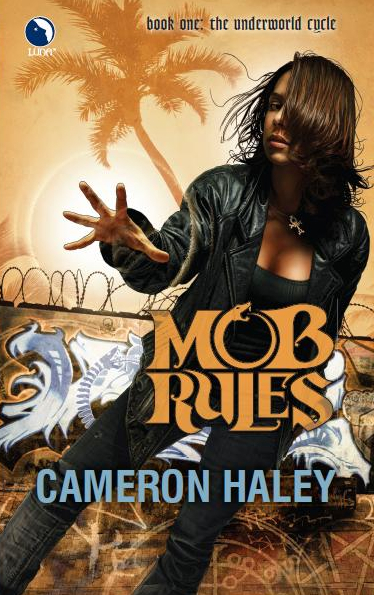Cameron Haley’s debut, Mob Rules, is a gritty UF tale of magic, murder, and the Mob.
Byrt: For people who haven’t read Mob Rules – what type of readers do you think would enjoy your book? Any particular authors you could mention, Amazon recommendation-style (i.e. if you like THIS, you’ll like Mob Rules).
CH: Reviewers have compared the book to Laurell K. Hamilton’s early, edgier Anita Blake novels. I’d also recommend it to fans of T.A. Pratt’s Marla Mason and Ilona Andrew’s Kate Daniels series. I’m a big fan of Jim Butcher’s Dresden Files, though Mob Rules is perhaps darker, more violent, and lacking the strong moral center you get with Harry Dresden.
Byrt: You absolutely nailed Los Angeles – how much of your city knowledge stems from personal experience and how much is research?
CH: First, I’m thrilled to hear an Angeleno say I got it right! I lived in L.A. for a year and still have good friends there. I think personal familiarity is important to get the feel of the city. No amount of research can replace that, and Domino’s little quips and jabs would sound off-key without it. And frankly, listening to the way my friends talk about the city—what they love and what they hate, the kinds of jokes they make and how they make them—is probably more valuable than the year I lived there.
The actual research is just to make sure the mundane details are right. You can get most of what you need with Google Maps and street view. In urban fantasy the city should be one of the characters. Research will give you physical description, and that’s important. But you need at least some familiarity with the city to show its personality—and what’s more important to a great character, physical description or personality?
Byrt: What made you want to write a Mob story? Were you inspired by real events or any particular era?
CH: The Godfather was one of the first adult novels I read, when I was maybe twelve years old. It made a lasting impression! When I sat down to write Mob Rules, I knew I wanted to do urban fantasy and I wanted the protagonist to be a sorcerer. At the beginning of the series, I wanted the supernatural to be hidden—there would be lots going on, but normal people wouldn’t know about it. And it just occurred to me that we already have this kind of hidden underworld—the criminal underworld—that we don’t really know that much about, and never interact with in our everyday lives. For an urban fantasy, what better place to hide the fantasy elements than the criminal underworld?
It’s a perfect fit, and all the mysticism and ritual in organized crime—at least the pop-culture vision of it—really cry out for the fantasy treatment. I realized I could put a supernatural spin on everything from crack houses and graffiti magic, to ritual executions and prison tattoos.
Byrt: Why LA? Why not Boston or Chicago?
CH: In a fair amount of urban fantasy, you could change the location and it wouldn’t really affect the story. Mob Rules isn’t that kind of urban fantasy. It’s an L.A. story. Partly, that’s the real and pop-culture association with modern gang activity. L.A. is really the capital of American urban or street culture. You know, if you’re doing Sex in the City, you want to put that in Manhattan. If you’re doing Mob Rules, it needs to be in L.A.
I’m actually surprised there isn’t more urban fantasy set in L.A. The subgenre is deeply informed by noir detective and crime stories, and L.A. figured prominently in that tradition, from Raymond Chandler through James Ellroy and Walter Mosley.
Byrt: I love Raymond Chandler. There’s a bit in one of his books, Little Sister, when Marlowe is driving west on Ventura to meet with an Agent, and he comments sourly on all the people driving like idiots. STILL SO TRUE…So were there any Urban Fantasy tropes you were determined to avoid?
CH: I’m one of those genre writers who really enjoys writing genre fiction. I’m not embarrassed or ashamed of it—I dig it. I really like working with the traditions and conventions of the genre and trying to put a fresh spin on them. I’ll admit, Mob Rules might read like I was working off a checklist: you’ve got your wizards, your vampire, your werewolf, your jinn, your pixie, a couple ghosts, etc. That’s intentional. It’s the first book of a series, and I wanted to let readers know what to expect from the world—supernatural stuff is real, so there’s probably at least a kernel of truth in most folklore. I also wanted to demonstrate that all those usual suspects of urban fantasy are no more played out than humans. Honey is a fun character, who also happens to be a pixie (sorry, piskie) warrior-princess. She’s no less fun just because we’ve seen pixies before in UF.
Now, there are some tropes in UF that I did want to avoid—some of the negative ones. Like the fact that, despite lots of strong female protagonists in the subgenre, the majority of these books can’t pass the Bechdel Test. Or the fact that the category is rather, ah, European on the whole. So I wanted to make sure there were multiple strong female characters in the book, as well as a full spectrum of ethnicities represented.
That said, I wasn’t on any kind of crusade, and really the whole setting is a poor choice for social or political statements since it imagines a fantasy world where things like gender and ethnicity don’t matter a whole lot. The real world is rather different, I think. Plus, pretty much everyone in the cast is a gangster or monster, so it’s not like the book deserves to be held up as some kind of progressive icon. What we really need are more women and more people of color writing and publishing books, and I’m neither. But, you know, even if you’re a white dude writing about gangsters and monsters inhabiting a world where people care more about what you can do than what you look like, it’s not that hard to include more than one woman. It’s not that hard to include African-Americans, Latinos, Asians. You might screw it up and you shouldn’t do it because you expect someone to praise you, but so what? Do it because it’ll make a better story, and if you get criticism for it, shut up and listen and maybe learn something from it.
Byrt: So did you pick a gender neutral nom de plume on purpose? Was there marketing pressure involved?
CH: It was the publisher’s call. You know, my job is to write, their job is to sell books. If they think the book will reach more readers with a gender-neutral pseudonym, that’s cool. I don’t want to deceive anyone and I certainly don’t try to keep my gender hidden, but I also think it’s a bad trend for readers to base their decisions about what to read on the assumed gender of the author. So, if they can’t tell whether “Cameron Haley” is male or female, perhaps they’re more likely to read the book just because it grabs their interest. That’d be cool.
Byrt: Can you tease what’s coming up next in The Underworld Cycle?
CH: I have a prequel novella called “Retribution” in the Harvest Moon anthology, which releases October 1. Domino clips a rival gangster who tried to move up the organizational ladder at her expense, and she gets hit with a nasty death curse as a result. The curse puts a contract on her head, and the hitter is a powerful spirit who may or may not be the Angel of Death.
In Spring/Summer 2011, the second book in The Underworld Cycle, Skeleton Crew, will be available. Domino is dealing with the personal and political aftermath of the events in Mob Rules when a zombie outbreak strikes L.A. Domino has to figure out why the dead aren’t staying down and put it right before the city becomes a necropolis.
It looks like the series will continue beyond these currently contracted books, but I’ll have more to say on that once I have something solid to report.
Byrt: And lastly – what books have you read recently that you’d recommend?
CH: K.A. Stewart’s debut, A Devil in the Details, released a couple months ago, and it’s a really fun read. The protagonist is a husband and father who works a lousy retail job and fights demons on the side to recover the souls of those who have sold them. The first three books in Stacia Kane’s Downside Ghosts series released this summer, and they’re excellent. And Harry Connolly’s second Twenty Palaces book, Game of Cages, released about the same time as Mob Rules. I recommend all of these highly.
Thanks again to Cameron for coming to the Bookyurt! You can learn more about Cameron at his website, here.
And Bookyurt’s review of Mob Rules is here.







